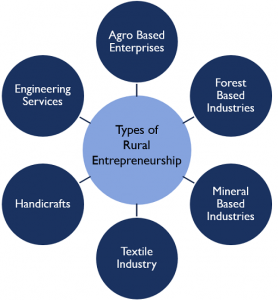Introduction-Rural Entrepreneuship
Rural entrepreneurship has opportunities for new ventures in rural areas.
In the true sense, barefooted only demands shoes. Similarly, underdeveloped areas are only in demand of growth. We should fulfil the requirements of the needy in the underdeveloped regions.

Details of Rural Entrepreneurship:
The title of the article draws attention to four words:
Rural:
The population is more in rural areas than urban areas. However, population density is higher in urban areas. As per the year 2018, statistical data, 65% of the Indian population live in rural areas.
Entrepreneurs:
An Entrepreneur is a risk-taking person. Because he is in the hope of earning more profit via business. But one should not forget that Business is done for the benefit of self and society.
Opportunities:
It means a time or set of circumstances that makes it possible to do something.
Challenges:
Challenge means something that requires sound mental or physical work to achieve the desired results.
Types of Entrepreneurship for rural areas:
As the title points out there are different opportunities of businesses for the entrepreneurs residing in rural areas of India.

For rural entrepreneurship first question arises, why to promote rural entrepreneurs? The answer is,
The rural area entrepreneurs will cause new enterprises in the rural areas of the country. Rural enterprises will help the society in following fields:

- formation of capital,
- regional development,
- employment growth,
- improved standard of life,
- increase in per capita income,
- reduction of population migration towards cities,
Opportunities for Rural Entrepreneurship in India:
The Rural Population of India is agriculture-based. And technology growth caused agriculture to grow.

Enterprises are slowly growing in rural areas,the reasons are:
- Investment is growing Multiple Businesses in rural areas.
- Private investors are taking the initiative to invest in villages.
- A large group of people is joining hands to crowdfund big projects in rural areas.
- Government and Private Entrepreneurs are designing programs to help new enterprises.
- Units are paying attention to the quality of their products and services to get acceptance in the market.
The Internet has changed our lifestyle in many areas :
- business style,
- education methods,
- government administration style,
- healthcare’s approach,
- ways in which we interact with each other via the internet,
It has become one of the key drivers of social evolution.
In Rural Entrepreneurship Other agriculture allied sectors:

- Dairy development: The Government of India is making efforts to strengthen infrastructure for the production of quality milk. Government and private parties are doing the purchasing, processing and marketing of milk and milk products.
- Poultry: In this sector eggs, and broiler production through hens is promoted.
- Horticulture: ‘Horticulture’ supports environmental enhancement through a special branch of horticulture called environmental or urban horticulture. It includes home gardening, landscaping, arboriculture (growing on trees), and interior decorating with the use of plants.
- Sericulture: ‘Sericulture’ is the cultivation of silk rearing of silkworms. It is an agro-based industry. It involves the raising of food plants and silkworms.
- For details please refer to:https://readwrite.in/agriculture-and-allied-activities/
Entrepreneurship prospects and challenges exist in Village industries as well:

These industries are grouped into seven categories as follows:
- Mineral-based industry: e.g. stone crushing, cement industries, red oxide making, wall coating powders making Units etc. This has improved the per capita income of society.
- Forest-Based Industry: e.g. Wood products, bamboo products, honey, coir industry, making eating plates of leaves units, etc., This has generated employment avenues for many in the poor class.
- Food-Based Industry: e.g. Sugar industries, jaggery, Oil processing, pickles, fruit juice, spices, dairy products making units etc. These are the daily needs of life.
- Chemical-Based Industries: e.g. Manufacturing of aloe vera gel, ball-pen ink, Aggarbatti making units, etc., This sector has increased Home-based industries.
- Engineering industry: e.g. Agriculture equipment manufacturing units.
- The Textile Industry: e.g. Spinning, weaving, colouring, bleaching units, etc., it has promoted poor communities.
- Service Industry: e.g. Tractors and Electric pump set repairing, etc., it has promoted solo enterprises.

Challenges and their reasons:
- The low level of purchasing power of rural consumers causes low sales volume for the new venture.
- New ventures are lacking in finance to make a business a feasible deal.
- Less number of customers leads to high competition and the low pricing of goods and services causes low profit and makes the project unfeasible.
- SSI units face difficulty in maintaining financial statements because of limited resources.
- Irregular weather conditions are the cause of production loss.
- The cost of transportation is high to outstation places.
Growth in Technology causing progress in rural entrepreneurship:
In recent years digital technology has helped farmers adjust their ways of working. Now they are paying attention to treating crops and managing fields. It has made farming more profitable, efficient, safer, and simpler.
Conclusion:
Rural entrepreneurship will grow, keeping in view the ample opportunities in various agricultural and village industries in India Though in villages pure drinking water and sanitation facilities are not available. Rural areas are lacking in infrastructure. Because society is short of resources to fulfil the demand.
However, the human being is a progressive animal and he will find the way to reach the destination.
